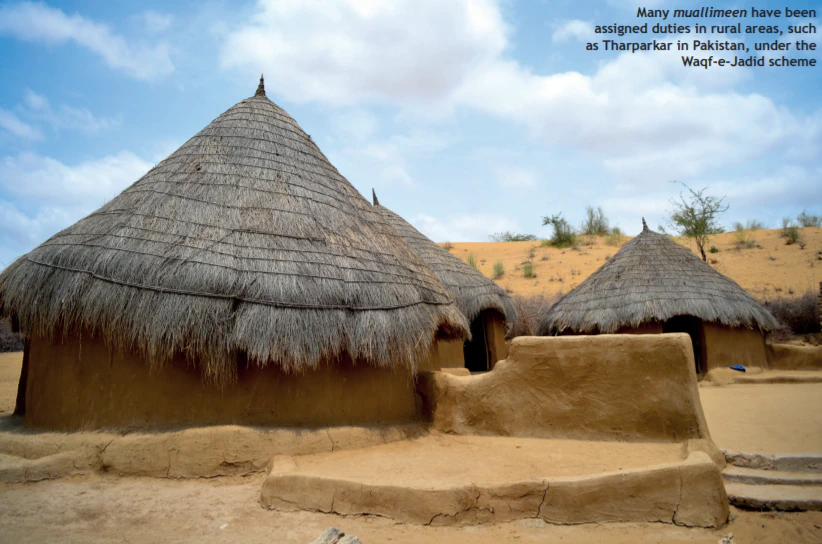وَ مَثَلُ الَّذِیۡنَ یُنۡفِقُوۡنَ اَمۡوَالَہُمُ ابۡتِغَآءَ مَرۡضَاتِ اللّٰہِ وَ تَثۡبِیۡتًا مِّنۡ اَنۡفُسِہِمۡ کَمَثَلِ جَنَّۃٍۭ بِرَبۡوَۃٍ اَصَابَہَا وَابِلٌ فَاٰتَتۡ اُکُلَہَا ضِعۡفَیۡنِ ۚ فَاِنۡ لَّمۡ یُصِبۡہَا وَابِلٌ فَطَلٌّ ؕ وَ اللّٰہُ بِمَا تَعۡمَلُوۡنَ بَصِیۡرٌ (266 :البقرۃ)
“And the case of those who spend their wealth to seek the pleasure of Allah and to strengthen their souls is like the case of a garden on elevated ground. Heavy rain falls on it so that it brings forth its fruit twofold. And if heavy rain does not fall on it, then light rain [suffices]. And Allah sees what you do.” (The Holy Qur’an, Ch: 2, Verse: 266)
On December 27th 1957 Hazrat Khalifatul Masih II(ra) started the blessed project called The New Dedication (Waqf-e-Jadid) Hazrat Khalifatul-Masih II(ra) planned to create a network of Mualimeen (Teachers) who should be wholly devoted to the upbringing of the members throughout the length and breadth of Pakistan Waqf-e-Jadid was the last initiative Hazrat Khalifatul-Masih II (ra)put forth before the Community On 1st February 1958, fourteen Mualimeen were dispatched to selected rural areas of the country – Now by the grace and mercy of Allah the number of Mualimeen is in thousands Sahibzada Mirza Tahir Ahmad Sahib (later to become Hazrat Khalifatul-Masih IV (ra)was appointed as the first Director (Nazim Irshad) of Waqf-e-Jadid

Constitution
152. Qa’id Waqf-e-Jadid shall motivate members of Majlis Ansarullah to participate in the financial sacrifices and other programmes of Waqf-e-Jadid.
Responsibilities
- “This is the undertaking of Allah, and He Himself will complete it. Since it is Allah Almighty Who has put this inspiration in my heart, I shall endeavour to fulfil it even if I have to sell my house and my clothes to do so and even if not a single person assists me. Allah shall cut them off from the Jamā’at who are not helping me in this regard and will send down angels from heaven to help me”(Friday Sermon, January 5, 1958)
What is Waqf-e-Jadid?
After the creation of Pakistan, the Ahmadiyya Jamaat spread across the country, settling in cities as well as smaller villages. While in India, many had lived in Qadian learning from the blessed being of the Promised Messiahas, his Companionsra and then the First and Second Khulafa.
However, such was not the case after the partition of the Indian subcontinent. Members living in large cities were able to benefit from the nizam-e-Jamaat and establish auxiliary organisations.
However, those living in villages did not have enough resources to resurrect the infrastructure of education and moral well-being required to bring about the spiritual transformative changes the Promised Messiahas taught.
From divine guidance, as a solution to this problem, Hazrat Musleh-e-Maudra initiated the blessed scheme of Waqf-e-Jadid (The New Dedication). This scheme was initiated on 27 December 1957 (it was first mentioned by Huzoorra on 9 July 1957), on the blessed occasion of Eid-ul-Adha.
“These lands were reserved for us. It is our duty to work in these lands and follow the footsteps of Hazrat Ishmaelas … these lands are densely populated, but not with spirituality … I desire that the youth of the Jamaat should dedicate their lives for this noble task.” (Friday Sermon, 3 January 1958)
In 1986, Hazrat Khalifatul-Masih IV (ra) broadened the scope of Waqf-e-Jadid and now all the countries of the world are covered by the Scheme. Waqf-e-Jadid is reaping enormous benefit in Africa where scores of Mu’alimeen (religious teachers) are undertaking the huge task of training people in the true Islam. This is a huge task and demands a huge sacrifice from each of us.
What are the Objectives of Waqf-e-Jadid?
Primary objective – to look after the spiritual upbringing of the members living in the rural communities
Secondary objective – to bring the message of Islam to Hindu population of the country
- The Hindu community in the Sind province was poor and was mistreated and exploited by the Muslim landowners. Seeing this, the Christian missions offered them financial help and thus influenced them towards Christianity. Waqfe Jadid carried out the huge task of bringing this Hindu community
into Ahmadiyyat and continues to do to this day. - Up to 1986 the project was intended mainly for the rural communities of Pakistan. However Hazrat Khalifatul-Masih IV (ra) broadened the scope of this project and now all the countries of the world are within the scope of this plan
Who should participate? Why should I participate?
Hazrat Khalifatul-Masih II(ra) stated:
“I emphasise to the Community that they should understand the importance of this scheme and devote their full attention to it and try their utmost to make it a success, ensuring that no individual in the Community who can afford it is left out.”
Hazrat Khalifatul-Masih Al-Khamis (atba)says:
“In this age of rampant materialism and commercialism when public, especially in the Western world, is bombarded with enticements to purchase merchandise, the Holy Qur’an guides us, setting forth the contrast of a “bargain” of striving in the way of Allah with one’s wealth.”
“Those who are well off should consider if the donations they make are real sacrifices” 6thJanuary 2006, Qadian
